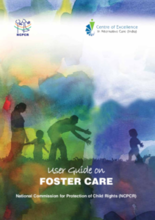This User Guide aims to provide a comprehensive approach to the development of a good quality foster care service in India, which will be useful for a range of practitioners including the Child Welfare Committee (CWC) responsible for approval and monitoring of foster families, District Child Protection Unit (DCPU) responsible for developing the foster care service, NGOs who may support foster care, and any individual or organisation who has a role to play.
The formal foster care system as outlined in this User Guide is not intended to replace kinship care, a good system that exists in Indian society but is for those children who don’t have the opportunity to be with their parents and relatives. It will be relevant for policy makers and managers and workers responsible for raising awareness about foster care, taking enquiries from potential carers, assessing the families, placing children, working with the children, monitoring the child’s placement and supporting the foster carers.
The User Guide should ideally be read first as a whole text, then used as a reference guide to work through different processes. Detailed guidance on significant steps and stages in the journey to foster care, are included.
The guide also includes some general chapters which will be particularly helpful to social workers responsible for the child’s placement, for example, chapters on attachment theory, impact of trauma on the child, supporting contact with biological families, meeting the child’s education and health needs and preparing the child for independence.
The three important national instruments – The Juvenile Justice (Care and Protection of Children) Act 2015, The Juvenile Justice (Care and Protection of Children) Model Rules 2016 and The Model Guidelines for Foster Care 2016 are the base for developing this User Guide and current rules and regulations are included in each chapter. The User Guide provides additional guidance on implementation of the regulations, and also proposes new areas of practice which have not yet been addressed in the legal framework.

